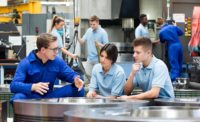When I last spoke to Drew Greenblatt, in March, the world looked a little different.
Drew Greenblatt, president of Marlin Steel Wire Products LLC (Baltimore, MD), says that his business has weathered the pandemic well. “We’ve had a good year so far,” Greenblatt says. “We’re focusing a lot on medical and pharmaceutical, which is a good place for us to be focused on. Those markets are growing.”
Since the pandemic began, the company has begun making hand sanitizing stands, ventilator baskets and test tube stands. While the company also works in automotive and aerospace, they are currently focusing on the markets that are thriving.
Since they were deemed an essential provider—no one is going to shut down a company manufacturing items for the CDC, Greenblatt says—the company never shut down. To ensure the staff remain healthy, the company follows CDC guidelines, with everyone wearing masks and also getting a temperature check when they enter the facility.
Unlike many companies, the company has had the same number of staff throughout the pandemic, and also offered consistent overtime and temporary staff.
“We have a very nimble, adaptable team that is very ready, willing and able to jump in and make a new product line after never doing it before,” Greenblatt says. He notes that everyone at the company knows someone who works at a bar, restaurant, casino, or theater, so they appreciate the chance to work and provide for their families during this uncertain time.
While this pandemic seems unprecedented, it is not the first time businesses have been disrupted by outside forces.
Greenblatt is no stranger to difficult times.
When he bought the company, in 1998, the company produced bagel baskets. Soon some problems became apparent. For one, Chinese companies started importing these baskets for less than the price of steel. The second issue related to the American stomach, specifically interest in low-carb diets. With the popularity of the Atkins diet, bagels plummeted in popularity.
His clients that did survive started trying to save money and switch to lower-cost vendors.
“That’s when we focused more on highly engineered parts. We were migrating to a new world,” Greenblatt says. “We’ve had to do this nimble process in the past, companies that don’t do that just die and become extinct.”
He offers this advice for manufacturers: “Listen to what the client is asking for, even if it is outside your comfort zone. If client is willing to pay for it and utilize your talents, it’s worthwhile to make something you weren’t accustomed to making in the past.”
In his case, that meant transitioning from bagel shops to medical or pharmaceutical baskets within a few years.
Adaptation
The news changes week to week and sometimes seemingly hour to hour. For those companies who were able to adapt to these changing conditions, like Greenblatt, there were some opportunities for new business. Others switched from brewing beer to making hand sanitizer, for example.
One pattern in terms of companies that were able to weather these conditions was the ability to be agile, says Kim Humphrey, president and CEO, Association For Manufacturing Excellence.
When we spoke this summer, she noted, “A lot of the companies that didn’t close during the pandemic are starting to see good increases in production. The ones that did close are starting back up.”
For companies that remained open, she said it was important to keep the workforce safe, and clearly communicate what the organization was doing to keep people safe. For example, one company moved to a two-shift operation with a 3.5 hour window between them to allow for cleaning procedures.
A Look at the Economy
While manufacturers’ experiences have varied depending on what they manufacture and where they are located, there are some obvious trends.
The economic impact of the pandemic has been dramatic for manufacturing, notes Chad Moutray, chief economist for The National Association of Manufacturers (NAM), an organization made up of 14,000 member companies.
“Between February and April, manufacturing fell pretty dramatically,” Moutray says.
Though the company appears to be in recovery mode, he says, “But it’s an uphill climb, not straight down and straight up again.”
He anticipates continued modest growth in 2021, and getting back to prerecession levels in 2022 or later.
“The American factory is very resilient,” Greenblatt says. “We’re going to come back.”


